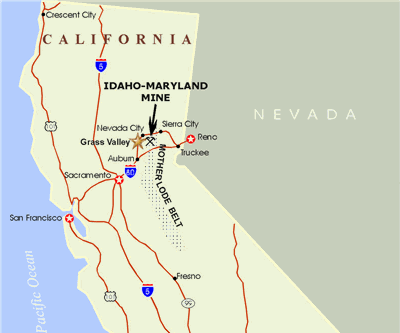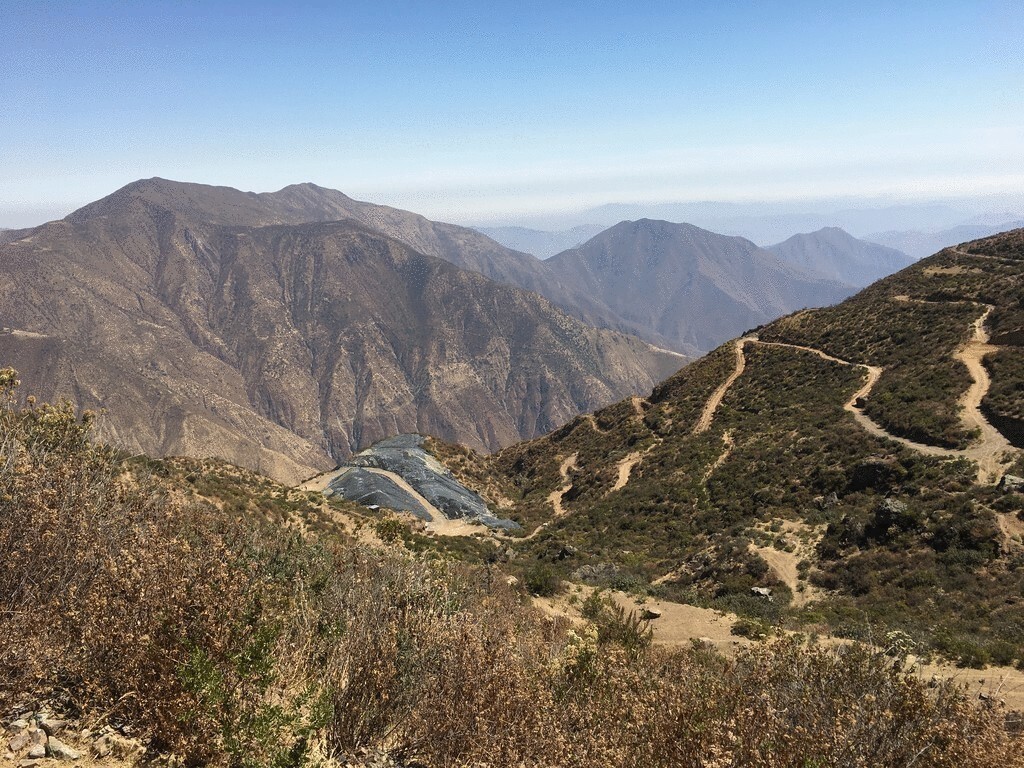Emgold moves forward with Idaho-Maryland project permitting

Emgold Mining Corporation (TSX VENTURE:EMR)(PINK SHEETS:EGMCF)(FRANKFURT:EML) (“Emgold” or the “Company”) provides the following update on its Idaho-Maryland Project (“Project”), located in Grass Valley, California. In follow up to the Company’s March 7, 2011 press release, Emgold, through its 100 percent owned subsidiary Idaho-Maryland Mining Corporation (“IMMC”), has commenced the filing process for its 2011 Revised Permit Application with the City of Grass Valley (“City”). The City is the Lead Agency and responsible for completing the Environmental Impact Report (“EIR”) for the Idaho-Maryland Project, as part of the California Environmental Quality Act (“CEQA”) process.
The Idaho-Maryland Mine was once the second largest underground gold mine in California and is reported to have produced 2.4 million ounces of gold at an average recovered grade of 0.43 ounce per ton. The mine contains a NI 43-101 compliant measured and indicated resource of 472,000 ounces of gold at a grade of 0.28 ounces per ton and an inferred resource of 1,002,000 ounces of gold at a grade of 0.39 ounce per ton, estimated as of March 1, 2007 (see Emgold’s NI 43-101 compliant Technical Report titled “Idaho-Maryland Mine Project” dated December 8, 2009 at www.emgold.com or, filed under the Company’s profile at www.sedar.com). A detailed summary of the Idaho-Maryland Project is also available at www.emgold.com and www.idaho-maryland.com.
Permitting History
Emgold is in the advanced stage of permitting the re-opening of the Idaho-Maryland Mine and is completing an EIR for the Project through its 100% owned subsidiary, IMMC. Since 2003 and in accordance with CEQA, IMMC has submitted to the City conceptual applications followed by the original 2005 Project Permit Applications. The City then completed a Master Environmental Assessment (“MEA”) for the Project in 2006. Subsequently, Emgold completed 2007 Revised Project Permit Applications to take into account community input obtained through the MEA process. The City and its consultant, Environmental Science Associates (ESA) then completed an Initial Study for the Project in 2007 and then prepared the Draft EIR, which was completed in October 2008. The public comment period for the Draft EIR was completed in January 2009. The Draft EIR concluded that, of the 15 areas evaluated, the Company was successfully able to avoid or mitigate potential environmental impacts of the Project in all areas, but one (air quality). This is a major accomplishment for any mining and/or industrial project, regardless of the jurisdiction.
After reviewing the Draft EIR, meeting with various government agencies to review their comments, reviewing public comments from the Draft EIR obtained during the public comment period (letters and public meetings), and obtaining input from the local community through IMMC’s community outreach program, the Company elected in mid-2009 to modify and clarify the project design contained in the 2007 Project Permit Applications to further mitigate and/or eliminate potential environmental impacts of the Project identified in the Draft EIR. Subsequently IMMC commenced technical work to modify and support changes to its 2007 Project Description.
During each phase of the permitting process IMMC has participated in local information sessions and held numerous consultation meetings in order to address stakeholder concerns and seek community input with its submissions to local, state and federal agencies.
Current Activity
On April 1st, IMMC submitted a check for US$25,000 to allow the City to commence the review of its 2011 Revised Permit Applications to determine their completeness. On April 8th, IMMC submitted drafts of the Revised Executive Summary, Introduction, and Project Description. Upon receipt of comments on the aforementioned submittals, IMMC plans to submit drafts of the Revised Formal Development Review Application and Mineral Project Application to the City by April 20th. Three other applications, the General Plan Amendment, Pre-zone, and Annexation Applications, that make up the remaining part of the Permit Applications for the Idaho-Maryland Project, have been deemed by the City to need no further revisions. IMMC’s goal is to have the 2011 Revised Permit Applications complete and accepted by the City at the end of April, 2011. A similar review process was completed with the City for its original project applications and for its 2007 Revised Permit Application.
Based on the modifications and clarifications IMMC has included in the Revised Project Description, IMMC anticipates that a Revised Draft EIR will be required and has been proceeding on this basis since mid-2009. The Revised Draft EIR will ensure the modifications and clarifications in the Revised Project Description are fully analyzed in the EIR. The Revised Draft EIR will also ensure that the public has the opportunity to comment on the revised Project as part of the CEQA process. In its letter to the City on April 1st, IMMC has requested that a Revised Draft EIR be completed and that the City expedite the decision on the requirement for IMMC to complete a Revised Draft EIR.
Key Modifications and Clarifications to the Project Description
The 2011 Project Description modifications and clarifications reflect the goal of Emgold and IMMC to ensure the Idaho-Maryland Mine Project is a socially and environmentally responsible project that will benefit the City, Nevada County, the local communities, and our shareholders. As the air quality analysis in the 2008 Draft EIR identified certain impacts to be significant or potentially significant, the primary focus of the modifications in the Revised Project Description was to lessen potential air quality impacts from oxides of nitrogen, random organic gases, respirable dust (PM10), and greenhouse gas emissions.
IMMC has completed significant work on air quality modeling for the Project and alternatives to address the air quality impacts outlined in the Draft EIR. Modeling done by IMMC’s air quality experts has significantly reduced oxides of nitrogen, reactive organic gases, and respirable particulate matter from previous estimates contained in the Draft EIR. IMMC’s proposed measures taken to accomplish these reductions include, but are not limited to, use of a Traffic Management Plan (e.g., van-pooling and car-pooling) to reduce employee traffic trips and associated air emissions, use of low NOX burners for combustion of natural gas, use of emulsion explosives, use of higher tier engines for off road underground and surface equipment, and use of shaft hoisting instead of trucking for material handling of ore and development rock.
To lessen potential impacts to the South Fork of Wolf Creek, IMMC has eliminated the water treatment plant and the water discharge to South Fork of Wolf Creek. Instead, a raw water line will be constructed under East Bennett Road. Dewatering of historic mine workings will occur at the New Brunswick site, with raw water transferred through the raw water line under East Bennett Road to the Idaho-Maryland site mine water detention pond. Any mine water discharged from the mine water detention pond at the Idaho-Maryland site will go through a water treatment plant to be located there, with discharge going to Wolf Creek instead of South Folk Wolf Creek.
Residents in the vicinity of the mine have expressed concerns that their domestic wells may be impacted by mine dewatering. IMMC has included in the project provision of an Nevada Irrigation District (NID) trunk line along East Bennett Road and feeder lines on roads proximate to East Bennett Road, to have an alternative supply of potable water available to hook up to residences should they be impacted. IMMC has provided a Domestic Well Level Monitoring Program and Domestic Well Mitigation Program which outline how domestic wells will be monitored through the life of the project and how impacts to domestic wells will be mitigated, should they occur.
IMMC has also provided additional information on the clean up of historic mine tailings remaining from past mining activities (prior to 1956) on the Idaho-Maryland site. This clean up was not included in the analysis completed by the City in the 2008 EIR and IMMC wants to ensure the positive aspects of this clean up are properly analyzed as part of the Project.
Additional modifications amd clarifications are contained in the Revised Project Description. Subsequent to finalization and acceptance of the 2011 Revised Permit Applications, the application documents will be made available to the public at www.idaho-maryland.com, www.cityofgrassvalley.com, and at the public libraries located in Grass Valley. This should occur in early May.
Expected Path to Move Forward with the EIR Process
Subsequent to acceptance of the 2011 Revised Permit Applications by the City, it is expected that the City’s consultant, ESA, will prepare a budget and schedule to complete the EIR process (Revised Draft EIR and Final EIR). Upon review of this budget and schedule by the City and IMMC, a decision will be made to proceed with the work or alternatively obtain competitive bids to complete the process. Once a decision is made to move forward, the City and IMMC will complete a revised Reimbursement Agreement. As part of the CEQA process, IMMC (as the applicant) is responsible for reimbursing the City and any its consultants for any costs to complete the EIR.
The City and its consultants will prepare the Revised Draft EIR. The Revised Draft EIR will be published and a public comment period will then commence with public meetings held through the City of Grass Valley Planning Commission. Subsequent to the public comment period, the Final EIR will be prepared by the City and its consultants. The Grass Valley Planning Commission will review the Final EIR and entitlements for the Project, make a determination if the documents are complete and adequate, and forward the package to the Grass Valley City Council. The City Council will be responsible for Certification of the Final EIR, approving the entitlements, and approving a Conditional Use Permit for the Project. Additional public meetings will be held when the Project reaches City Council. It is anticipated that the Final EIR will be completed in late 2011 or early 2012.
David Watkinson, President and CEO of Emgold stated, “We have been working hard over the last year and a half and believe that the revisions to the Project will eliminate, reduce, or mitigate a number of potential impacts identified in the Draft EIR. While air quality was identified as a significant issue in the Draft EIR, the significance, in the case of nitrogen oxides, is a result of Nevada County being a non-attainment area for ozone (nitrogen oxides are a precursor to ozone). Nevada County has high ozone levels due to air that blows into the Sierra Nevada Mountains from the San Francisco and Sacramento area, not due to local emissions. As such, the significance level the mine has to meet is much lower than in an area that is not a non-attainment zone. We expect to meet the nitrogen oxide significance level for several project alternatives that will be analyzed in the EIR. We are also required to deal with AB32 legislation in California, in the CEQA process, even though the state has yet to adopt many provisions of this law, including defining of ‘significant levels’. We look forward to completion of the Revised Draft EIR and Final EIR with these changes incorporated.”
For more information about Emgold, the Idaho-Maryland Gold Project and the Buckskin Rawhide, Stewart, and Rozan Properties, please visit www.emgold.com.
Image is from Emgold. You can read the full news release here.
{{ commodity.name }}
{{ post.title }}
{{ post.date }}

Comments